Welcome to the CK Draft Guide for Innistrad: Midnight Hunt! The original Innistrad set an extremely high bar for Limited gameplay, frequently described as an all-time favorite by veteran players. It will take more time to properly judge the success of Midnight Hunt against its predecessor, but early signs are strong. The mechanics are novel and intriguing, the pool of playable cards is deep.
It’s a classic horror franchise sequel – and today, we will learn how to bend its cast of witches, werewolves, ghosts, geists and vampires to your will!
IT’S A GRINDHOUSE CLASSIC
The first thing I try to understand about any Limited format is the overall theme and makeup of the set. What types of cards are more or less common than in other sets? Which are stronger or weaker than usual, or in different colors than you’d expect? And how do the games usually play out?
In my experience so far, the answer is “board stall.” It’s very easy for both players to quickly put three or more creatures into play, slowing the pace to a zombie-like shuffle as you search for ways to chip in damage or build incremental value into a decisive lead.
We’ll delve deeper into exactly why this happens in next week’s “By The Numbers” draft analysis — but essentially, teams of small creatures are better at blocking than attacking. When both players have a wide board of 2/1’s and 1/3’s and 3/4’s, any attack is an opportunity for your opponent to pull ahead, multi-blocking some threats and safely absorbing hits from others.
And Midnight Hunt makes it much more difficult to swing those calculations back in your favor. Stats are generally smaller, so defenders can focus their blocks on crushing attackers instead of preserving every possible life point. It’s also harder to find keywords like flying, trample and first strike, especially on larger creatures. Even the combat tricks in this set are built to force trades between creatures rather than prevent them, making it harder to sustain momentum as an aggro deck – so long as your opponent keeps playing blockers.
DRAFT ARCHETYPES: THE COLOR(S) OF FEAR
So, what should your draft priorities be, based on all this? A high overall creature count matters more than their specific stats or mana costs — although having a balanced spread is ideal. Once you have the ability to hold up your side of the battle line, make sure you have a plan to break through theirs!
Every draft archetype in Midnight Hunt has its own preferred ways to navigate the board stall, which we now examine in gruesome detail…
WHITE-BLUE – DISTURB TEMPO
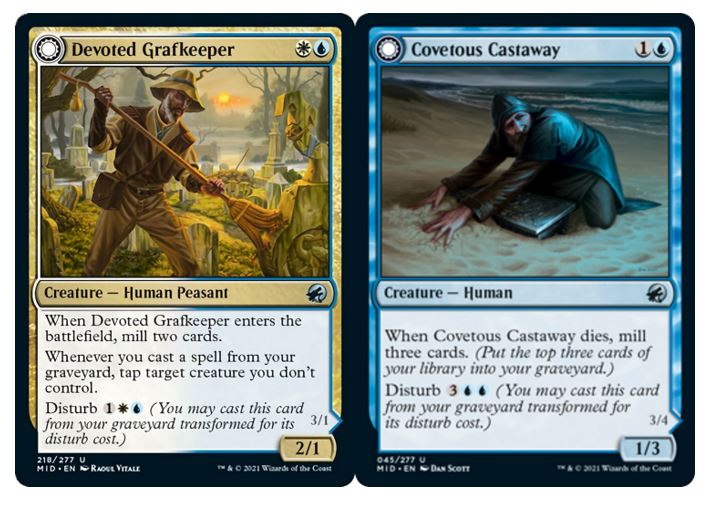
Fans of aggressive blue decks rejoice: this is the strongest set for that playstyle I can remember, with both blue-white and blue-black offering powerful options. This version is the more balanced one color-wise; both white and blue offer a strong batch of early flyers and disturb creatures, and both possess the efficient interactive spells to help you “hold serve” and close out the game before bigger decks get into top gear.

Disturb is definitely the key here, acting like a cheat code to get the high creature counts you need for reliably sealing up the ground, and conveniently providing the vast majority of Midnight Hunt’s flyers. Other colors — particularly red and black — can find it extremely difficult to stop even the smallest geists, and with games being so slow on average, just two or three damage in the air is a serious threat. The mounting pressure will force opponents into desperate action, whereupon your counterspells and combat tricks can finally grant them the Blessed Sleep.
BLUE-BLACK – DECAYED TEMPO

The other great tempo deck of the format, blue-black plays a surprisingly different game to blue-white thanks to its own signature mechanic: decayed. While blue’s disturb creatures and flyers are still vital — even more so without the white ones to help fill those slots — this deck can build up a lot of extra damage thanks to the virtually-free Zombie tokens stapled onto various commons.
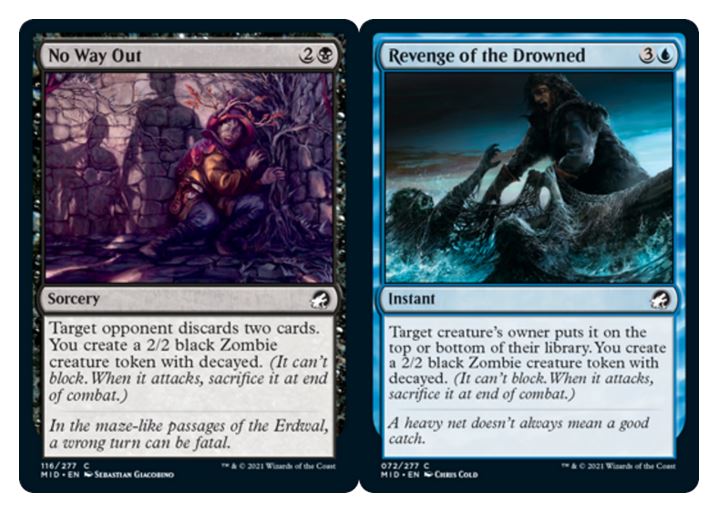
I haven’t met a decayed-making card I didn’t like in Draft, but it is important to be a little greedy in how you utilize the tokens. They only get to attack once, so you should consider even a two-damage hit the bare minimum use of this precious undead resource! Far better to keep those fleshbags around like intimidating garden ornaments, until you can spend them on one of UB’s many sac outlets. And if you still want more, Fleshtaker and Rite of Oblivion are splashable!
Even if you aren’t sacrificing your tokens, you can still increase their damage potential with Bladestitched Skaab, or drive up their value with Morbid Opportunist and other death triggers. Even cards like Bladebrand take on new life when the body you “spend” on them is so cheap! Whether you curve out with Falcon Abomination and Morkrut Behemoth, or pick apart the opponent with interaction while stockpiling Zombies for the slower win, the best blue-black decks are very hard to beat.
WHITE-BLACK – ON-DEATH VALUE
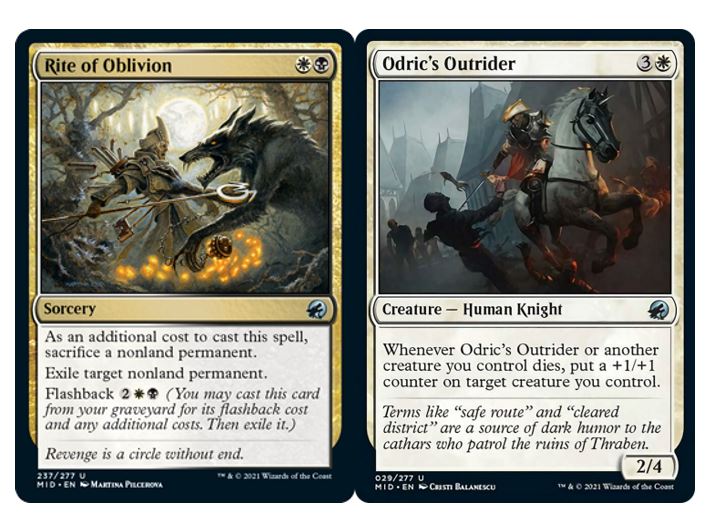
Experienced players can probably put together what this color combination does well based on the white-blue and blue-black archetypes. You can make a lot of cheap disturb and decayed creatures very quickly without running out of gas. But where this deck differs from the blue ones is the ultimate plan to win once those bodies are stalling up the board. Instead of forcing a race with flyers and using counterspells to cut off any response, white-black embraces the board stall and grinds the opponent out over time, gaining value from its creatures both in life and death!

You can still use all of black’s sac outlets and decayed tokens as described above — now with even more great death triggers like Unruly Mob, Bereaved Survivor and especially Odric’s Outrider! Fleshtaker and Rite of Oblivion are the strongest gold uncommon pair in the set, and of course you can splash a few of the blue options here just as easily as we borrowed those two in blue. In fact, having such a wide array of non-decayed bodies to back up your Zombies lets you send them into battle much more confidently. The threat of a lethal Ritual of Hope will often force blocks which expose valuable creatures to tricks like Bladebrand, Covert Cutpurse or Blessed Defiance. If they don’t, well, you can always fall back on a suite of Midnight Hunt’s best removal — or surprisingly fast burn kills from Siege Zombie and Dreadhound.
GREEN-BLACK – CLASSIC MIDRANGE

In a sea of novel archetypes dominated by unique set mechanics like decayed and daybound, it might seem unusual to sum up green-black simply as “midrange.” But it’s all about what green brings to the table in Midnight Hunt. I have it firmly middle-of-the-pack in terms of power, but it does a few things well. With the Werewolves, it has a monopoly on large, efficient creatures which can survive the set’s typical multi-blocks.
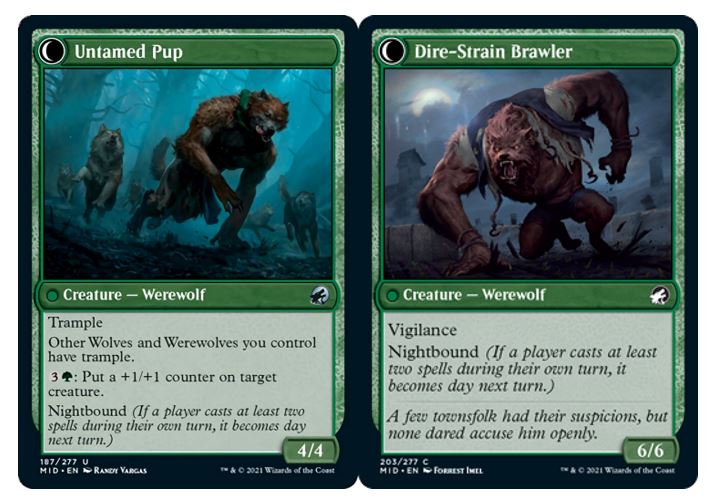
With hard removal in other colors somewhat limited, its well-costed fight spells become very competitive interaction, further leveraging that size advantage. And green also has perhaps the strongest top-end of any color, with a combination of ramp, fixing, lifegain, and any late game bombs you want — many of which are in green, anyway. What do all those strengths have in common? They work best in the context of long, grindy games! So that’s what we use our suite of destructive, trade-focused black cards to help set up — and cash in on with the usual suspects like Siege Zombie and Morbid Opportunist.

Yes, I will go on the record here and say that Werewolves are much better in a grindy midrange plan than your typical curve-out Gruul beatdown. It’s no accident that black gets its own share of common and uncommon lycanthropes this time around. The ability of Werewolves to force strong trades on attack is contingent on having them flipped, and often on having several of them flipped and attacking together. That’s far easier to set up when you’re not in a hurry, and you can use black’s removal and discard to run opponents out of spells they would otherwise use to disrupt your precious night-time.
WHITE-GREEN – COVEN VALUE

Another white deck, another new way to capitalize on a wide board and awesome combat tricks! White is definitely neck and neck with blue for Midnight Hunt’s strongest color — and what makes it even more appealing is that all white color pairs play in a similar style. While that does imply closer competition with other drafters for the same cards, it turns out that very few white commons and uncommons are below-average; and in a Draft format where commons and uncommons tend to decide victory, that makes white-focused drafting highly consistent. I’m definitely a little biased towards my favorite color, but I do recommend hovering around the Abzan colors as a “default” strategy, one which reliably leads to stable grindy decks from many combinations of commons.

But just how does white-green grind through opposing boards? The answer is again a signature set mechanic, this time coven. Most of the coven abilities are extremely relevant for pressuring in combat — be it evasion from Candlegrove Witch and Harvesttide Sentry, brute force from Dawnhart Mentor and the awesome Duelcraft Trainer, or slowly upgrading your board with Contortionist Troupe and Ambitious Farmhand. The latter theme is supplemented by other white cards like Odric’s Outrider and Gavony Silversmith, while your disturb flyers offer the perfect home for these targetable buffs.
You can be equally effective in green-white at any pace: overloading on powerful two-drops that evade opposing blockers as you establish coven, going wide with Ritual of Hope and Dawnhart Wardens, or just keeping a wall of blockers as you chip away with a single buffed attacker backed up by Flare of Faith.
WHITE-RED – CURVE-OUT AGGRO

As I warned in the beginning of this guide, your typical curve-out, always-attacking aggro decks are at their weakest in Midnight Hunt. But should you be a dedicated beatdown specialist, the red-white color combination offers your most respectable chance to crush weak openings and keep the slower, value-focused decks on the back foot. White-red is the combination of choice because it can lean on white’s plethora of decent attackers – red itself being, sadly, the weakest color of the set by some margin.

However, that is not to say that red brings nothing good to the table; its overall card quality is just too low compared to the others, and the gaps in its toolset are too wide for it to serve as a good base color. Instead, we can cherry-pick the standout weapons: combat tricks, burn spells, card selection and the occasional strong attacker. It’s worth noting that some otherwise mediocre red creatures such as Harvesttide Infiltrator and Voldaren Stinger can be greatly rehabilitated by white’s combat tricks and +1/+1 counters, letting you capitalize on their powerful keywords. Special shout-outs to Festival Crasher, a card which is a trap in basically any other archetype, but can have its day here thanks to extremely efficient white spells like Homestead Courage.
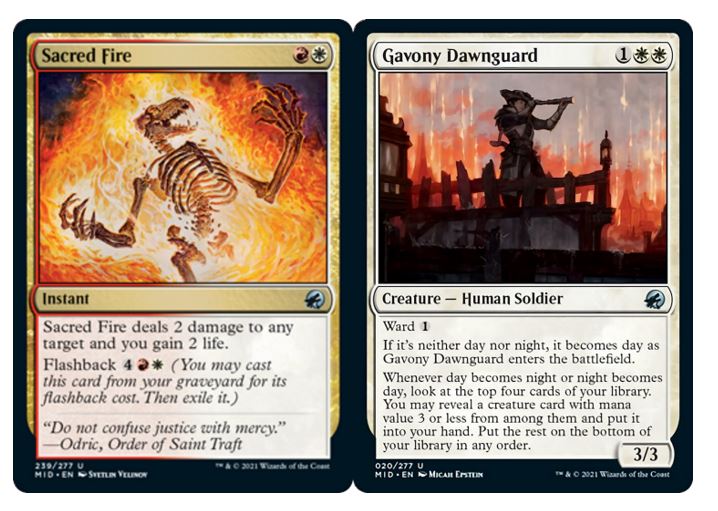
Just remember, though: this deck gets there more often than other red combinations because it benefits from the same white value engines as archetypes like white-green. Don’t miss the chance to snatch up an Odric’s Outrider, Gavony Dawnguard, or Cathar’s Call — or more rarely, red options such as Obsessive Astronomer, Flame Channeler, and the powerful Geistflame Reservoir.
RED-BLACK – ALL-IN AGGRO

I really don’t like saying this, but my first recommendation for drafting red-black decks in Midnight Hunt is: don’t do it.
Seriously, my advice is to avoid playing this color combination even if it appears open, and even if you get a good rare or two. The stats on many of red and black’s cheap common and uncommon creatures are extremely weak, and most combat tricks you have access to will not help them survive a block. It’s a little staggering to me that Midnight Hunt is the set where black misses out on having something like Demonic Gifts or Unlikely Aid, since persisting through horrible damage is a signature move for horror movie monsters.
But without such tools, red-black finds it very tricky to push in damage at any point without spending cards — and this combination has the hardest time generating card advantage in a format where that sort of thing is already rare. What tools red and black do have tend to be at their weakest here, slowing your tempo dramatically or pushing you towards creatures which don’t attack well. Nothing epitomizes this like the daybound creatures; while both red and black have access to Werewolves, needing to take a turn off to get them in working order often robs you of whatever momentum you were hoping to squeeze out of their slightly-bigger statlines.
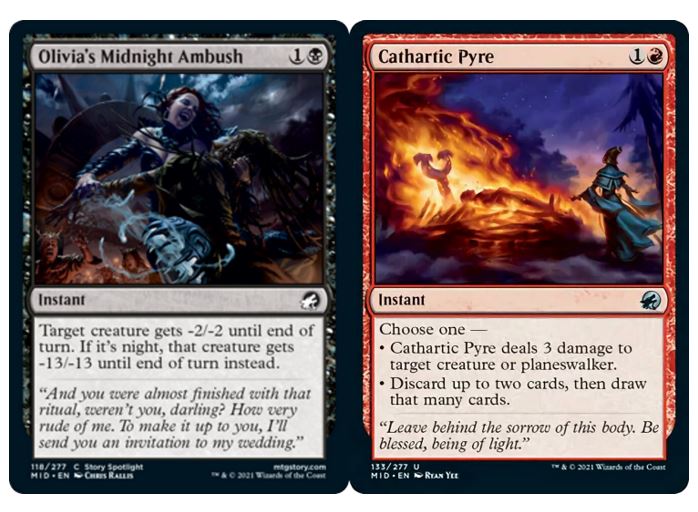
Being short on long-term value while trading early cards for damage will leave you way behind the boards of white and green decks before you know it, while blue and black can stabilize and keep you off the finishing blow with interaction. I suspect that if red-black decks are successful, it’s by going all-in on multiple Vampire Interloper and other evasive/direct damage cards like Siege Zombie or Thermo-Alchemist — where you can most effectively trade cards like Lunar Frenzy for chunks of life instead of getting tied up in a losing ground war.
RED-GREEN/RED-BLUE: 4C FLASHBACK PILE!
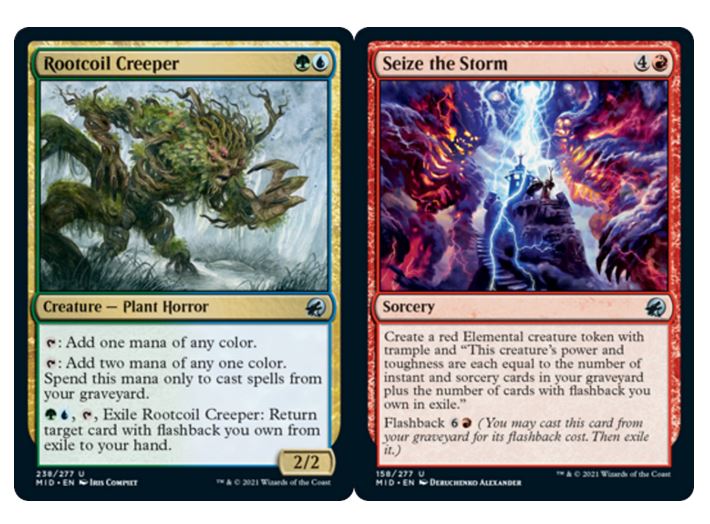
And so after that slightly dire rundown of red-black’s fortunes, we can finish on what is maybe the most crowd-pleasing deck of the format! That’s right, four-color soup is back on the menu, thanks to a just-right amount of fixing and the powerful, unconditional late-game value of flashback.
I’m lumping red-green and red-blue together here, because the base-green Temur deck is significantly more reliable than either red-green Werewolves or red-blue spells. That’s not to say that either of those archetypes is bad – I would rather play either of them than the average red-black pool. But when it’s already so easy to pick up a few Evolving Wilds, Eccentric Farmers, and Dawnhart Rejuvenators along the way? There’s simply no reason to limit yourself from picking the best cards from the third color, and usually the late game black ones to boot. Temur this may be, but I still rate Dreadhound and Diregraf Rebirth among your most powerful win conditions.

With such a loosely defined archetype, it’s difficult to give pinpoint strategic advice. But in general, I would encourage you to be greedier here than you would be in other sets, so long as you have your solid core of early blockers to stall the board. Slower games will give you ample time to find your colors, and to cash in the full effects of cards like Dryad’s Revival, Shadowbeast Sighting and Rise of the Ants. It’s just the cherry on top that most of your fixing cards can offer a lot of toughness to the cause; even Crossroads Candleguide and Mystic Skull are very playable!
You can also introduce white to this mix, either in place of black or as a fifth color if you’re really adventurous. But aside from Faithful Mending or some particularly great rares, white tends not to offer much to a deck with plans this big. Leave the “best color” to the other drafters, and mop up the cream of the remaining crops!
HUNTING DOWN THOSE DRAFT TROPHIES
That’s most of what you need to know to get started with Midnight Hunt Draft. As different as it is, I think the more methodical pace of this set makes it easier to pick up on which cards and colors are strong as you play. Certainly my opponents have started going out of their way to murder Siege Zombie on sight!
But if you’re interested in more in-depth analysis of which cards overperform in this format and why, make sure you come back next week, where we’ll pore over the data in the second part of this guide: “Midnight Hunt Draft By The Numbers!”

Tom’s fate was sealed in 7th grade when his friend lent him a pile of commons to play Magic. He quickly picked up Boros and Orzhov decks in Ravnica block and has remained a staunch white magician ever since. A fan of all Constructed formats, he enjoys studying the history of the tournament meta. He specializes in midrange decks, especially Death & Taxes and Martyr Proc. One day, he swears he will win an MCQ with Evershrike. Ask him how at @AWanderingBard, or watch him stream Magic at twitch.tv/TheWanderingBard.

